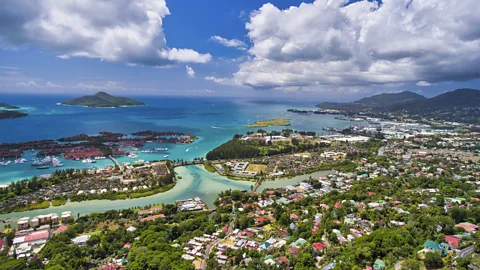16 March 2022
By Alba Jaramillo, Features correspondent
The Seychelles vows to protect 30% of its ocean territory (Credit: Paola Giannoni/Getty Images)
As tourism has impacted parts of Seychelles’ environment, the island nation now aims to protect its 72 low-lying coralline “Outer Islands” from development before it’s too late.
Made up of 115 islands dotting the Indian Ocean off East Africa, Seychelles is known as a global hotspot for biodiversity. With as much as 85% of its animals and 45% of its plant species considered endemic, the archipelago is sometimes called the “Galapagos of the Indian Ocean”. And both on land and in the ocean, different groups are working to preserve this ecological paradise.
This year, after creating a sophisticated zoning plan and completing extensive conversations with representatives from the country’s tourism, fishing, petroleum and conservation efforts, the island nation is prepared to fully implement the landmark Marine Spatial Planning Initiative it announced several years ago: to protect 30% of its ocean territory. Tourism, climate change and other factors have already greatly impacted the environment of the Seychelles’ more populated “Inner Islands”, so this agreement – part of a deal to write off its national debt in exchange for conservation measures – is now aimed at protecting its 72 low-lying coralline “Outer Islands” from development before it’s too late.
The Aldabra Atoll, a Unesco World Heritage site, is one of the Outer Islands that the initiative will help preserve. This rare cluster of coral reef islands has been somewhat naturally protected for years due to its remote location (visitors require a special permit for access and must travel a whole day to get there), but, like many parts of the Seychelles, it is still susceptible to the dangers of climate change. In 1998, the Seychelles lost 90% of its coral reefs in a major coral bleaching event as a result of rising sea temperatures. The 13 new Marine Protected Areas are intended to preserve its ocean territory.
Despite the environmental gains the protection areas will bring, the agreement has not been without its challenges. For example, in these new protected areas – which encompass an area the size of Germany – about half of the country’s previous fishing areas would be off limits.
However, Seychelles claims it’s looking to bridge the gap between the ambitious initiative and the immediate needs of local economies by including stakeholders (such as fishing and tourism workers) in the conversation.
It’s known as a global hotspot for biodiversity
“We are very small. We have very limited land mass, and we need the space for economic development,” said Sherin Francis, chief executive of the Seychelles Tourism Board. “But yet we manage to strike that balance and ensure that 50% of our land territory is protected.”
The ocean isn’t the only part of Seychelles that’s being preserved. On land, the National Parks Authority guards over two main areas, Morne Seychellois Park and Praslin National Park, both of which are home to an extensive list of endemic animal and plant species. Morne Seychellois Park, located on the largest island of Mahé, covers 20% of the island’s surface, provides fresh water to locals, and is crisscrossed by trails that pass historical ruins from when French and British colonists and Indian and Chinese traders passed through the islands. Praslin National Park is home to the Vallée de Mai Nature Reserve, a palm forest on the Unesco World Heritage List.
The parks’ official designation was established once the Seychelles started growing as a tourist destination, a few years after the first international airport was built and the island nation gained its independence. Similar to the initiatives at sea, the national park status was meant to help protect the land while creating an infrastructure to allow visitors to enjoy it by walking more than 15km of trails and viewing its rare bird species and plants.
With all eyes on their landmark conservation goals, Seychelles is gearing up to show how such a small nation can become an example for the many other insular countries facing the effects of climate change. Hopefully, it’s not too late.
Source link : https://www.bbc.com/travel/article/20220315-africas-global-biodiversity-hotspot
Author :
Publish date : 2022-03-16 07:00:00
Copyright for syndicated content belongs to the linked Source.
